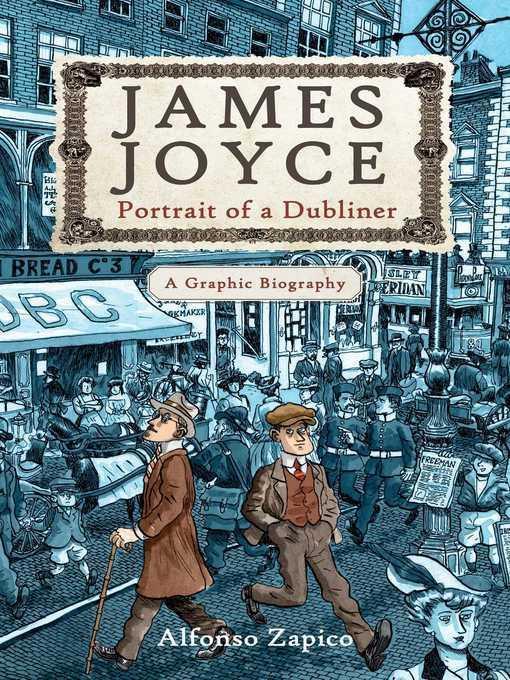
James Joyce
Portrait of a Dubliner?A Graphic Biography
کتاب های مرتبط
- اطلاعات
- نقد و بررسی
- دیدگاه کاربران
نقد و بررسی

February 15, 2016
This lively, beautifully drawn portrait of the writer is among the best recent graphic novel biographies, and Zapico (La guerre du professor Bertenev, Cafe Budapest) won Spain’s National Comics Prize when it was originally published in 2012. Zapico takes us from Joyce’s early days as the eldest of 10 siblings, to the friendships and acquaintances of young adulthood, to the crafting of his masterworks. Uncompromising, stubborn, and a raging alcoholic whose addiction should have cost him his marriage and his sight (from chronic iritis), Joyce is presented in many roles, including father and intellectual, and not always in the most flattering light. The strong cartooning is what makes this work. Zapico’s art teems with details of architecture, and the characters are looser but bursting with emotion—both elements are indispensable to understanding Joyce’s peripatetic life. The art not only establishes a sense of place, but shows how these places were unable to contain an indomitable spirit like Joyce: save for Dublin, which, of course, contains his soul. An early candidate for the “Best Of” lists for 2016.

March 15, 2016
A graphic biography of the literary master. Though "breezy" isn't a term generally associated with the author of Ulysses and Finnegans Wake, artist Zapico (Cafe Budapest, 2008, etc.) remains true to the life and spirit of the Irish master while appealing to readers who might not have the patience for either Joyce's novels or a standard, more exhaustive biography. There is far more text here than in most graphic narratives, beginning with the Joyce generations prior to the birth of James--or "Jim" as he's frequently called in these pages--and ending with his death and literary legacy. Zapico shows how Joyce's mother's religiosity and his father's alcoholism and uncertain finances produced a tension in the schoolboy, who was advised to be a priest and was considered "clearly on his way to sainthood." However, he rejected his religion and became something of a vagabond in exile, accepting random teaching assignments and drinking and whoring his way through his young adulthood, all the while writing the early work that would have such trouble getting published. Much of the narrative concerns his love-at-first-sight relationship with Nora, on whom he depended but whom he also resisted as she bore him children and constrained his tendencies toward dissolution. His prose became more radical, and perhaps even more Irish, the farther he strayed from Ireland and the longer he stayed away. His homeland and its characters lived within him. "Writing from a distance, Joyce always dealt with the subject of Ireland," writes Zapico. Ulysses would mark his turning point, his most ambitious and audacious work at the time, one that would be banned in the States as immoral yet ultimately became a sensation when published. "While the effect of Ulysses on the reader is rather sickening," said the judge, "it would be unfair to call it 'aphrodisiac.' " Then came another major leap, with Finnegans Wake raising the bar even higher before Joyce's premature death. A solid account of the development of a writer not easy to encapsulate.
COPYRIGHT(2016) Kirkus Reviews, ALL RIGHTS RESERVED.

May 15, 2016
Dubliner James Joyce (1882-1941) was notoriously difficult in multiple senses, and Spanish illustrator Zapico (Cafe Budapest) spares none of the novelist's personal complexities or contradictions. Full of dodgy schemes as a youth and an impossible drunk and whoremaster as husband to the long-suffering if beloved Nora Barnacle, Joyce crafted some of the most admired if least actually read-to-the-end literary works in English. The expressive ink-wash drawings bring to life early 20th-century Dublin and Europe--indeed, the historical period elements, as well as warts-and-all renditions of Joyce, Irish nationalists, and assorted luminaries, come through visually with intellect-tickling charm. Note that while Zapico reports on the checkered reception of the author's output, there's not much about the writings themselves. Don't expect help in understanding why and how Ulysses and Finnegans Wake are as difficult as novels--evoking praise, disgust, and censorship--as Joyce could be as an associate. VERDICT This biography is an enjoyable, valuable introduction to Joyce for students and literary-minded readers, high school and up. See also Mary M. Talbot's Dotter of Her Father's Eyes, which looks at the Joyces' relationship with their daughter, Lucia.--MC
Copyright 2016 Library Journal, LLC Used with permission.

March 15, 2016
Readers familiar with James Joyce only through his dour dust-jacket photos are in for a big surprise in this warts-and-all graphic biography of Ireland's best-known and perhaps most divisive writer. Following Joyce's life from early childhood until his death, Zapico reveals Joyce's challenges and triumphs, both personal and professional. Readers will surely sympathize with Joyce's ongoing medical issues and his daughter's tragic mental illness, but they'll also feel for his wife and especially his brother, who worked relentlessly to support them all even as Joyce capriciously spent those earnings on food and liquor. Special care is taken to convey the political state and artistic climate of Ireland and greater Europe and their subsequent impact on Joyce's work. Using a traditional sequential panel format, the black-and-white, ink-wash illustrations are surprisingly expressive, capturing Joyce's jocular manner and rabble-rousing with an indulgent yet objective hand. Because it reveals its subject without sensationalizing or glamorizing him, readers will close the book with a better understanding of a complex man and his influential work.(Reprinted with permission of Booklist, copyright 2016, American Library Association.)

























دیدگاه کاربران